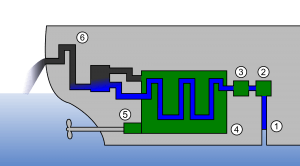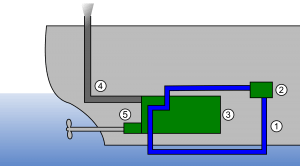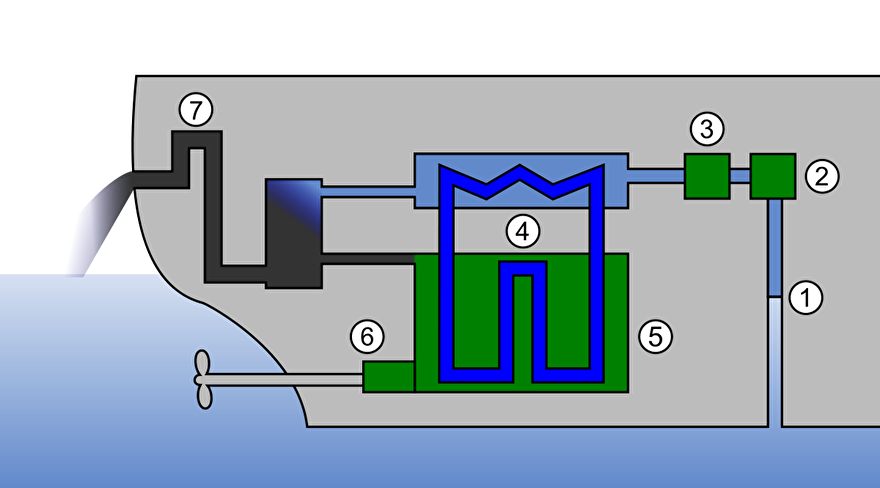This page has been translated with google translate, there may be errors in the stories.
Which cooling systems are there?
Direct cooling: the outboard cooling water flows directly through the engine's cooling water spaces. this type of cooling is mainly found with old 1 and 2 cylinder engines from the 1970s.

Direct cooled engine. (1 shut-off valve, 2 strainer, 3 impeller pump, 4 motor, 5 gearbox, 6 unloading system.
Advantages and disadvantages of direct cooling.
Benefits:
Simple installation and therefore also a cheaper engine installation.
Downside:
The motor does not reach the usual working temperature of 80 to 90 degrees (Celsius).
The working temperature must be kept below 60 degrees, otherwise a lot of precipitation (lime, salt, scale) will form in the cooling compartment of the engine.
As outside water flows through the engine block, the interior of the engine will be exposed to corrosion and the cooling spaces can fill with sediment (sand / mud).
Due to the lower working temperature, the wear process will be faster.
An impeller pump is required for the supply of the raw water, the impeller is subject to wear and should not run for more than 30 seconds without water. If it runs without water for longer, the impeller will become too hot and will burn.
Impellers must be periodically checked and replaced if necessary.
Kim / Kiel / Flat or Beunkoeling: Also called “closed” cooling. The coolant flows through the cooling water spaces of the engine, then this coolant flows through a tube under the ship or through the keel or a bundle of pipes that is cooled by contact with the outboard water.:

Cooling in half of pipes under the hull. (1 tube system, 2 impeller pump, 3 motor, 4 dry discharge, 5 reverse gear.
Advantages and disadvantages of bilge cooling.
Benefits:
Reliable installation. If the V-belt breaks, the alternator light will usually come on and you have a few more minutes to stop or anchor (the V-belt drives the cooling water pump and alternator).
When the correct coolant is used, frost damage is excluded (this means that you can also sail in winter) and the cooling system is protected against corrosion. The warm coolant can be used to heat the boiler and, if necessary. CV on board.
Downside:
This system often has a dry exhaust, which can be a fire hazard.
This can be solved by installing an additional cooling water pump that injects water into the exhaust.
The exhaust manifold is not optimally cooled. The exhaust manifold is often also an expansion tank, where the warm cooling water from the engine is further heated (often to boiling temperature), so that cooling water is spit out.
The lubricating oil of the gearbox and the engine are not optimally cooled by the warm coolant.
With external cooling pipes or cooling surfaces, the cooling capacity can become too small as a result of fouling and / or thick layers of paint. The engine then gets too hot with all that that entails.
Indirect cooling: Also called separate cooling system. The same as with bilge cooling, except that the outboard water (which cools the coolant) is pumped through the heat exchanger by means of an additional pump. This system is on most modern motorcycles.

Indirectly cooled engine: (1 shut-off valve, 2 incinerator, 3 imeller pump, 4 impeller pump, coolant pump, 5 motor, 6 gearbox, 7 wet unloading system.
Advantages and disadvantages of intercooling.
Benefits:
The outside water can cool the exhaust (wet exhaust). The outlet hose with waterlock is easy to install yourself.
The seawater can cool the lubricating oil of the engine and the gearbox well. As a result, old worn out engines often have a little more oil pressure.
The warm coolant can be used to heat the boiler and any central heating on board.
Downside:
Complicated by the additional cooling water pump. More expensive due to the heat exchanger and impeller pump (necessary for suction of the raw water). However, if the correct coolant is used, frost damage to the engine block is excluded and the internal cooling system is protected against corrosion.
In winter, the heat exchanger and outboard cooling water pump must be drained.
How can you prevent cooling problems.
Know your cooling system. Follow the pipes, locate the inlet valve (also check the open and closed position) and the seaweed filter.
When the engine is cold, check the level of the expansion tank.
Check immediately after starting (with wet exhaust) whether water flows out of the exhaust.
Check that the temperature gauge is working properly and that it always indicates the same temperature.
Take a look at the engine if you are going full speed for a long time.
Never continue sailing if you have doubts about the proper functioning of the cooling system.
Cooling problems can cause the engine to overheat, causing the cylinder head to warp and leak. The problems then get worse.
So never sail too long with cooling problems and let an expert look at it!
Do not ignore alarms and make it a routine to check the engine daily before sailing and immediately after sailing. A starting problem can be solved better than if it has been going on for some time!
How can you recognize a non-functioning cooling system?
It is possible to recognize a non-functioning cooling water system before the engine temperature alarm goes off. In a cooling system, the water usually goes through the discharge and if, for example, a blockage, broken cooling water pump or a closed shut-off valve does not allow cooling water to pass through the discharge, a dull noise will come from the discharge. As soon as it appears that the cooling system is not working, the engine must be switched off as soon as possible and if this is not possible, use as little gas as possible to get to the side if you are in a river or canal.
With a directly cooled engine it is a good reason to clean the cooling system every few years with an engine descaler / cleaner as in the link.





